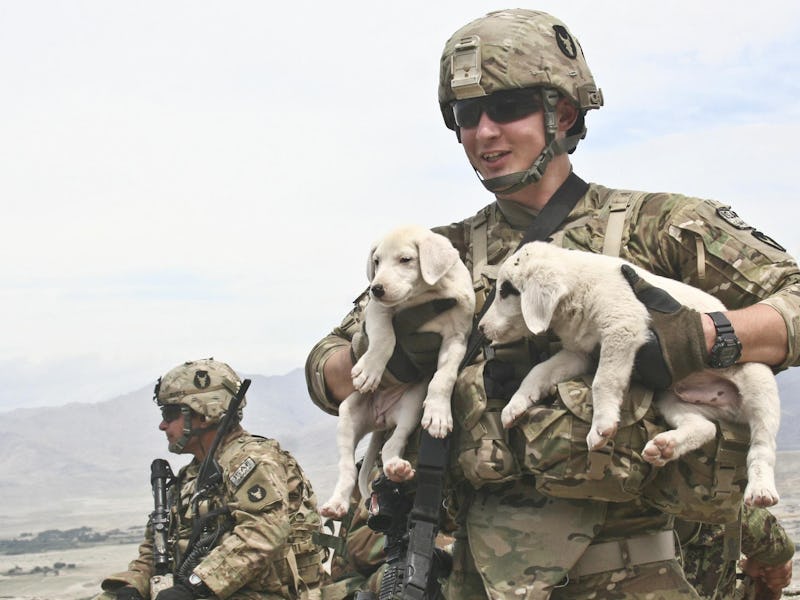A Brief History of Dogs at War
Man's best friend is man's enemy's worst nightmare.

In the new summer flick Max, a U.S. military dog (named Max) returns from a tour of Afghanistan, where his handler Kyle was killed on the battlefield. The PTSD-afflicted Belgian Malinois is adopted by Kyle’s family, including his younger brother Justin, who forms a special bond with the dog. The two help each other grow up and heal and a bunch of other stuff. At the end, people feel better but Kyle remains deceased.
Cliched plots aside, Max is a character that would have seemed realistic to people born thousands of years ago. Dogs have long been supporting actors in theaters of war. Canines remain better than even robots for fighting, keeping guard, relaying communications, scouting, and tracking mines. Here’s a brief history of Canis lupus familiaris in warfare.
Mid 7th Century BCE
One of the oldest documented instances of dogs being used in battles was during the Greek war between the Ephesians and the Magnesians on the Maeander. When the two armies were marching towards one another to meet on the battlefield, Mangensian horseman would release dogs and allow them to run into the enemy ranks, followed by an assault of spears before the horseman finally charged on the Ephesians.
525 BCE
King Cambyses II of Persia lined dogs and other animals up in at the front lines of his army in the Battle of Pelusium. The defending Egyptians—who regarded animals as scared—refused to shoot a single arrow for fear of wounding them, allowing the oncoming Persian army break through the Egyptian army without much trouble.
231 BCE
Roman legions led by Marcus Pomponius Matho invade Sardinia, and engage the locals in guerrilla warfare. Matho and his soldiers used dogs from the Italian mainland to hunt natives hiding in caves and other naturally-formed nooks.
55 BCE
Before he became the dictator of the Roman Empire, Julius Caesar’s conquest of Gaul stretched into Britain. The Celtics met Rome’s forces with English mastiffs. Caesar’s description of them in his accounts make them one of the oldest recorded breeds.
An pensive-looking English Mastiff, possibly thinking about the Celtic-Roman battles his ancestors may or may not have been a part of.
16th Century
Spanish conquistadors widely employed the use of mastiffs and other breeds in their invasion of the New World and their subjugation of Native Americans.
World War I (1914 - 1918)
Allied and Axis forces alike used dogs to deliver messages back and forth. Sergeant Stubby is one of the most famous—the Boston bull terrier was used by U.S. forces, taking part in combat and surviving injuries sustained by grenades and mustard gas. He eventually reached the rank of sergeant after singlehandedly capturing a German spy in Argonne. True story.
Sergeant Stubby
World War II (1939 - 1945)
To defend against invading German tanks, the Soviet Union devised and carried out a despicable plan that strapped explosives to dogs (mostly German Shepards) and sent them charging headfirst towards tanks. This produced only limited success, partially because the Russian army trained its dogs through its diesel-powered tanks, rather than gasoline-powered Russian tanks—familiar only with the smell of diesel, the bomber dogs would run towards Russian tanks instead of German ones. Still, the Russian military continued to train “anti-tank dogs” up until 1996. (The U.S. also trained anti-tank dogs in 1943, but wasn’t insane enough to actually deploy them.)
Also during WWII, the U.S. Marine Corps used dogs donated by American civilians to help in the liberation of Pacific islands occupied by Japan. Doberman Pinschers became the official dog of the USMC. Most of the dogs that survived the war went home with their handlers.
A Marine in Iwo Jima takes a nap while Butch stands guard.
The Vietnam War (1966-1973)
The U.S. Army employed the services of about 5,000 dogs, which are estimated to have saved the lives of over 10,000 American soldiers. Although only 232 war dogs were killed in action, only 200 that survived the war were assigned to other U.S. bases outside the U.S. The rest were euthanized or left behind in the country.
An US solider and Chief (German Shepherd) on patrol in Vietnam.
2011
US Navy SEAL Team 6 used a Belgian Malinois military dog named Cairo during its mission to kill Osama bin Laden. Cairo was tasked with tracking anyone who tried to escape and raise alarms about any Pakistani security forces who might be approaching. (Cairo got to meet President Obama afterward, but reportedly failed to shake his hand.)